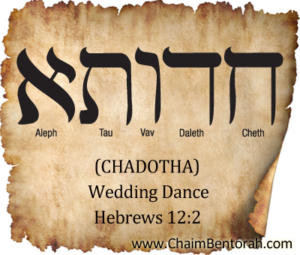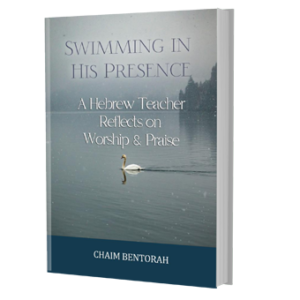ARAMAIC WORD STUDY – THE WEDDING DANCE – CHADOTHA חדותא Cheth Daleth Vav Taw Aleph
Hebrews 12:2: “Looking unto Jesus the author and finisher of [our] faith; who for the joy that was set before him endured the cross, despising the shame, and is set down at the right hand of the throne of God.”
 I reserved a special time to study God’s Word today. There were other things I needed to do but I just felt compelled to sit down and study a passage of Scripture. After about three hours of searching for a particular Scripture to study, I began to despair that I was wasting a lot of valuable time as I just could not feel that quickening of my spirit as I examined dozens of Scripture passages. But I just felt strongly that I must study something and in desperation, I cried out to God: “There are a half dozen tasks that are left undone that I need to attend to if I have to live in this world. If you want me to study something in your Word you have to show me, otherwise, I cannot sit here wasting time that I could use getting these tasks accomplished.” And then an old song that I have not heard for years came to my mind and lips. “Turn your eyes upon Jesus, look full in His wonderful face and the things of the world will grow strangely dim, in the light of His glory and grace.” – Helen H. Lemmel. I was then led to Hebrews 12:2.
I reserved a special time to study God’s Word today. There were other things I needed to do but I just felt compelled to sit down and study a passage of Scripture. After about three hours of searching for a particular Scripture to study, I began to despair that I was wasting a lot of valuable time as I just could not feel that quickening of my spirit as I examined dozens of Scripture passages. But I just felt strongly that I must study something and in desperation, I cried out to God: “There are a half dozen tasks that are left undone that I need to attend to if I have to live in this world. If you want me to study something in your Word you have to show me, otherwise, I cannot sit here wasting time that I could use getting these tasks accomplished.” And then an old song that I have not heard for years came to my mind and lips. “Turn your eyes upon Jesus, look full in His wonderful face and the things of the world will grow strangely dim, in the light of His glory and grace.” – Helen H. Lemmel. I was then led to Hebrews 12:2.
I have heard this verse many times throughout my life but I never really meditated on it. I went right to my Aramaic Bible. I knew the Greek had a very interesting insight but I wondered if the Aramaic would give me an ever greater depth of understanding. You see, in Greek the word for looking is aphorontes from the root word aphorao which has the idea of looking away from everything else to focus your gaze upon one thing. The Aramaic word is nachor from the root word chor which is reflexive and has the idea of making oneself transparent. It is a word that you would use when a bride and groom look upon each other when sharing their wedding vows. They are committing themselves, their lives, their whole being to each other for the rest of their lives, they are promising to forsake all others, to always be there for each other, to open their hearts to each other and bare no secrets from each other. A single English word for chor would be transparency. It is to look at each other with transparency.
Would you like Chaim Bentorah as your personal Hebrew teacher?
|
|
Looking unto Jesus is not just looking at him but making yourself transparent to Him as he makes Himself transparent with you. It is like a bride and groom looking at each other as they commit themselves to each other for the rest of their lives. At that moment they become transparent, sharing something with each that they will not share with anyone else in the world.
The wedding motif actually carries on through this entire verse. Jesus endured the cross and the shame associated with the cross for the joy that would result from it. He did it not only for us but for the joy that the sacrifice would bring to Him. Just as the bride and groom sacrifice their personal lives and their singleness for the joy of being together. Yet, that word joy is an amazing word to use here in this passage. It is the word chadotha in the Aramaic. This is the word used for the joyful dancing at a wedding. This again carries that wedding motif. The vows have been said as we and Jesus gaze at each other sharing our vows. We tell Jesus that we are giving Him our lives and our hearts and now we enter that wedding feast where there is a wedding dance. In the traditional wedding dance couples line up opposite each other. Depending on the culture and whether traditional orthodox or not either men and women face each other or members of the same sex face each other, the symbolism still remains the same. They then move toward each other and then back away, always chor, gazing at each other, never taking the eyes off each other. Each time they back away, they move back to each other only this time drawing closer to each other. This is to declare that the bride and groom will have times when they will struggle in their marriage and they will momentarily separate from each other, but as they look chor or gaze at each other they will be drawn back to each other only this time a little closer. This is what the Apostle Paul is describing in this wedding motif that we will dance this wedding dance. It is a joyful time of expressing our commitment with Jesus and He with us. Even though we may sin and draw away from Jesus, He will always keep His gaze on us and we will be drawn back to Him only each time we return we will be drawn closer to Him. Jesus will use our human frailties that the enemy would seek to use to draw us away from Him only Jesus will use it to bring us closer to Him.
So we have the wedding ceremony where we gaze at Jesus in transparency leading us to the joy of the wedding dance and now the groom takes his place at the right hand of the Father at his daqurasih in Aramaic from the root word quras which is a chamber with an upholster chair or a divan, what we call a love seat, that is a chair made for two people to sit closely together. It could also be a bedroom and the way the syntax word suggest we could read this as the bedroom in His Father’s house. This is where the groom Jesus would take us His bride to consummate our marriage to Him.
So next time you hear this verse, stop and consider that the Apostle Paul might be sharing something even more intimate than we the surface understanding of this verse indicates. It is also speaking of our marriage relationship to Jesus and the intimacy that He longs so much to have with us that he endured the suffering of the cross in order to obtain it.
Hi there! Thank you for reading this Daily Word Study. Can I ask a favor? Share this Daily Word Study with your friends on Facebook and Twitter by clicking one of the icons below.
Thanks & Blessings, it means a lot to me!







This is a great lesson because so many people need to hear about Jesus. He is most important now more than ever before. I find things about Him in the Old Testament and I know that you see them too. Would you write about them because it would help people to believe.